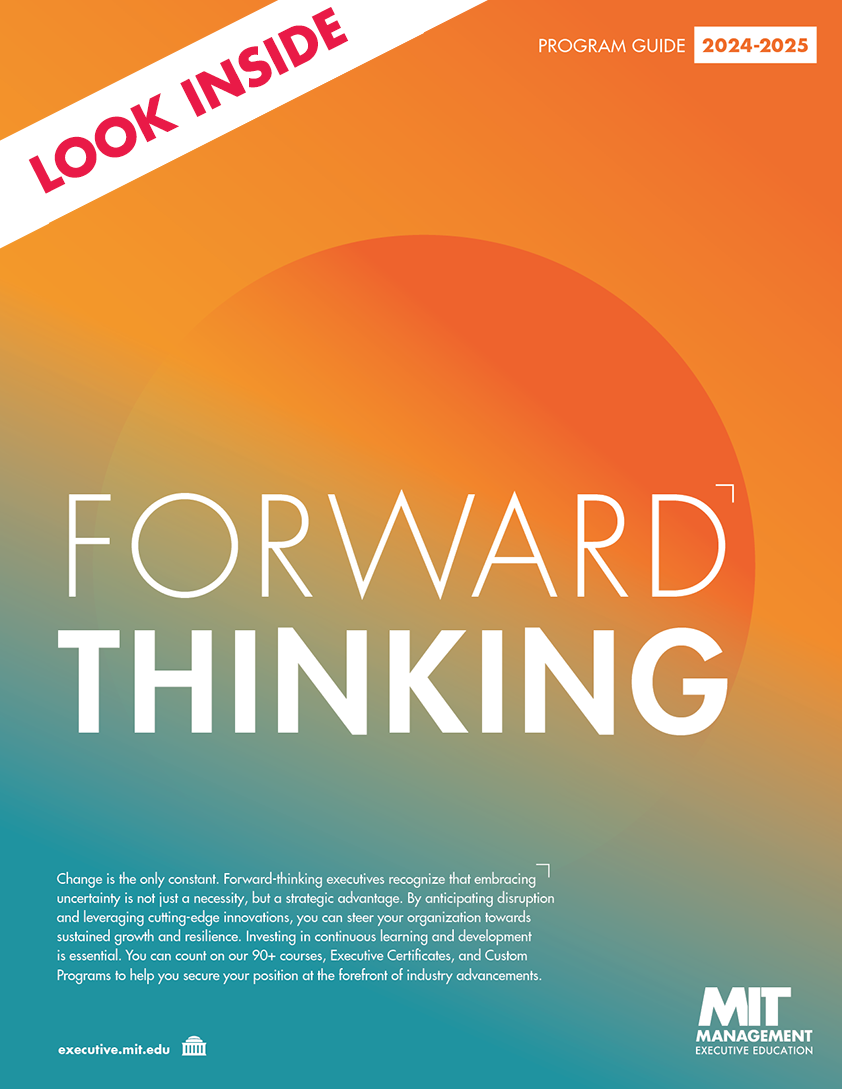By Kristin Zecca, Director, Executive Programs and Lecturer, MIT Sloan Executive Education
In the volatility of today’s labor market, one thing seems certain—both employers and employees expect some degree of flexibility in every aspect of work, whether it’s office location or hours, business travel or hiring incentives, and so on. Professional development—or custom executive education, in our case—is part and parcel of this landscape, and MIT Sloan Executive Education had to adapt quickly to continue to be a valued resource for our existing clients and to attract new ones since the pandemic disrupted business-as-usual.
Navigating the hybrid environment
What we found most eye-opening about the hybrid environment was how our approach to business had to change. “Whereas many companies are trying to find one model that they think will work for them, we are saying, let’s design something that works for the business and allows individual flexibility as long as it supports business needs,” says my colleague Laura Ziukaite-Hansen, Senior Director, Executive Programs. These days, the return to office discussion is less about health concerns and more about people’s preference, she points out. Some want to be back in the office every day because it offers a clear delineation between life and work, a quiet dedicated work space, a sense of professional community. For others, the pandemic has reinforced their conviction that they can be as or more productive working from home; people may have moved further away and have longer commutes, etc.
For employers, this means creating an atmosphere where employees can thrive and continue to grow professionally, and meet them where they are individually. Organizations are looking to institutions like MIT Sloan for guidance on how to reengage in custom executive education programs that may have been put off for the past two to three years but to do it in a way that takes into account these different comfort levels.
“For some of our clients, especially large global firms, digital has been a preferred way of delivering executive education for many years,” notes Ziukaite-Hansen. She explains that for those clients, the pandemic strengthened the position that digital is the way of the future for a variety of reasons. It is more disruption-proof. It offers more choice (live online, asynchronous, blended) and scheduling flexibility. Digital is a travel-free solution that comes with significant cost and time savings, and it is more in line with sustainability goals and commitments of many of our client companies. There are also pedagogical advantages, albeit with considerable tradeoffs—most of our clients miss the collaborative and immersive nature of face-to-face learning but appreciate a less concentrated learning approach with more opportunities to apply it in between, that the digital provides. For other clients, especially those that pre-pandemic always relied on a face-to-face learning model, the transition to digital was more challenging. Some were willing to experiment, others decided to wait it out. What we are seeing now, is the tendency to embrace a hybrid/ blended learning model that tries to balance these tradeoffs for maximum value and impact.
“As a business, we reacted to the disruptions cause by the pandemic with agility and speed, transitioning our programming to digital in a few weeks’ time. It was as impressive as it was challenging,” Ziukaite-Hansen reflects. “What we saw was this incredible collective dedication, collaboration and resourcefulness to reimagine our business and execute on it on a very short timeline, but always with the best customer experience in mind. I think that's a lesson that we should not lose sight of when we think of what’s possible and what we are capable of. I hope we can maintain this organizational agility and change mindset and can deploy it even in the absence of a massive shake-up.”
Our colleague Meg Regan, Senior Director and lecturer at MIT Sloan, and her team experienced that type of open mindset when a long-term client (a multinational bank) made the decision to switch entirely online mid-program in order to maintain momentum. This organization has a deep partnership with MIT and the trust built over the years made the transition to digital much smoother. A program delivery was underway when the pandemic halted the world, but the client wanted to keep going!
“We carefully crafted a blended learning journey that incorporated online live and self- paced sessions, small group networking, office hours, action learning work and client run open discussion sessions. As a result, over 1,200 executives, including boards and C-suite leaders are using a set of common language and frameworks around digital transformation and several action learning projects have been implemented in the business.
In custom executive education, active client involvement and commitment are an important ingredient to success for a large scale, cascading engagement to have significant impact. “The bank’s team was actively involved in curating and creating material for the online platform as well as engaging internal experts and the bank’s leadership in the content of the program,” says Regan.
Integrating into the blurred work-life balance
The pandemic forced us to integrate work and life and also to set boundaries between the two. And sometimes the boundaries are fuzzy. Companies want to support their leaders and managers in learning how to lead in a new environment where they're managing teams of individuals who all have different needs and where there's a call for respecting the individual and the human needs and balancing that out with the business needs. For instance, one of the unexpected but encouraging outcomes of digital-only delivery has been an increase in women participating. One can’t help but think that some of these participants are able to attend our programs now because they fit better with their other commitments.
Pre-pandemic, we would see longer client engagements, companies bringing employees together for a week, sometimes for multiple weeks, in cohort experiences on campus. What we're seeing now is the desire to provide an interactive digital experience that can engage a broad range of employees across the world without the disruption of travel. Companies who have accepted that people can work from home successfully are translating what they're doing in their day-to-day work environment into executive education programs. How do we think about this differently? How do we integrate the learning experience with the everyday lives of the executives who have to continue doing their home life, work life, and continue to develop capabilities in order to be competitive and build their careers?
In the before times, the experience might be condensed to the time that participants are on campus and a little time before preparing, and doing project work afterwards. Now, with work life and executive education integrated into their day to day, we may do something over a period of weeks where they're still learning new content, frameworks, and research insights that they can apply to their work.
People are learning in smaller pieces. They have an opportunity to take that small piece and apply it to a project in real time. They may have the opportunity to work on a team project and have an hour of teamwork where they're getting to know colleagues from across the world. And they're finding a way to work together online. Executive education is giving them an opportunity to learn how to develop new capabilities, broaden their skills sets, build relationships across the company, and create a new common language while working in a hybrid environment.
Bringing the best of all worlds
There are three types of programs and engagements that we're seeing right now:
- A completely online experience with live and asynchronous learning and a combination of the two
- What we at MIT Sloan Executive Education call “a blended” program, where a company may kick off the learning in a live online environment and have three to six weeks of two to three hours a week of learning and then come to campus for two to three days for some type of a traditional classroom engagement to benefit from being together in person, learning together in person, networking, and experiencing being able to focus away from the work environment
- A fully in-person live experience on campus
The spectrum of executive education is changing, requiring a higher level of customization, a higher level of work integration, weaving together the learning with work in such a way that it actually works—works for people's family and work schedules and career development goals. We are seeing a desire for a highly interactive engaged in-person experience. In many cases, we're seeing a trend with shorter programs on campus. This is forcing us to think creatively and to rethink our approach to high-touch experiential events and how we're going to deliver the learning and the capability building to our participants, our executives, organizations we've engaged with in multiple formats, so that we ultimately have an impact while companies are transitioning to hybrid working environments.
Whatever an organization’s comfort level with the digital component, everyone is expecting a meaningful and engaging experience. One of Ziukaite-Hansen’s long-standing clients is a technology firm. “While a large portion of the content was delivered live online, we would always have a residential component. The digital did not have to carry all the weight of the interactive experience, because there was always an in-person component to fall back on for highly interactive activities such as simulations, application work, report-outs etc.,” she recalls. “Then, during the pandemic, we had to transition exclusively to digital. How do we create a learning journey for our clients that is not only stimulating intellectually but is interactive and delivers value through collaborative application work—in an exclusively virtual environment?” They redeveloped simulations originally intended as hands-on classroom activities to be delivered digitally instead. They also started using collaboration tools more broadly and more effectively. Introduced asynchronous learning components to give people an opportunity to engage with content in a variety of ways.
“Are these groundbreaking examples? Probably not in isolation, but thoughtfully integrated into the digital program design, they helped create a cohesive and impactful learning environment,” she says.
Focusing on people
Participants in the MIT Sloan Executive Education programs have been learning the importance of people skills for a long time and in varied contexts, and the last couple of years have really tested managers’ capacity in those areas. Interpersonal and leadership communication, creativity, resilience, empathy—all these have become equally important to business strategy or analytical skills.
Why is it important for leaders to be able to demonstrate empathy and actually be empathetic? Because at the core of any organization are people, and people have gone through all sorts of different challenges or changes over the past two and a half years. Many leaders are asking, how do I lead and manage in this environment that is completely different than the traditional environment in which I developed as a leader?
People are still struggling. Many are struggling with burnout right now from managing multiple aspects of their lives for the past few years and the weight of the pandemic. So how do you keep your company thriving? How do you keep your employees engaged? How can leaders be empathetic while also managing the daily needs of the business and the long-term goals of the business? We see a huge shift towards the human aspect of leadership, the people skills. It was there before, but now I think people realize it's more important than ever.
There's a higher demand for coaching services and coaching skills. Many of our core leadership concepts here at MIT Sloan are based on managing distributed teams. We have been teaching leaders how to cultivate and coordinate across matrixed, multifunctional and flat teams for many years.
We teach problem-focused leadership: how to we engage leaders in solving practical challenges. And this is exactly what we have today—a practical challenge with a hybrid working environment and an exhausted workforce that keeps showing up and doing their best every day. We are all part of it.








